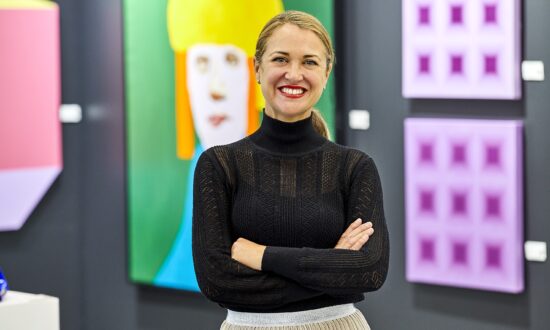Brisbane-based First Nations artist Ryan Presley has spent the last eight years developing the concepts behind the body of work featured in Fresh Hell – his largest and most ambitious solo exhibition to date. Through his practice, Presley uses political and historical references to create works that talk about what is happening now, with a particular focus on the treatment of Aboriginal people in Australia.
The exhibition has been curated by Patrice Sharkey, the artistic director at Adelaide Contemporary Experimental, and Gertrude Contemporary’s artistic director Mark Feary. Following this presentation, Fresh Hell will travel to Melbourne, where it will be on display at Gertrude in early 2023.
ACE has been transformed for the exhibition, with the space divided into smaller rooms accessible via archways. Presley is exploring architectural ideas around chambers, cathedrals, labyrinths and how spaces are built for audiences to have a spiritual experience. The layout of the exhibition affords quiet reflection and allows the viewer to engage with the works from expanding and contracting viewpoints.
Fresh Hell is a collection of colourful, playful, confronting paintings that use canonical Christian iconography traditions as their starting point. Presley creates scenes inspired by familiar images of saints, Old Testament prophets and Biblical figures, but his protagonists are young Aboriginal men and women. By replacing these key figures and other symbols in the images, the artist presents an alternative narrative as he explores themes of power, race and colonialism.
Presley is drawn to compositions of historical images with a particular focus on the movement and power imbued within them and the way they are designed to enforce drama. For instance, in Aeronautics (what goes up must come down) the artist references the iconic imagery of St Francis Receiving the Stigmata, replacing the saint with three Aboriginal men defending their land. The Christ seraphim is replaced with helicopters fitted with probes that mining companies use and there is an open-cut mine in the mid-ground, suggesting the work is about the power of the mining industries.

Ryan Presley’s Fresh Hell at ACE. Supplied image
Another work, The Trial (Live dogs and dead lions) draws its inspiration from St Michael – Archangel of the Apocalypse, but in this instance, Presley has replaced the archangel with a young Aboriginal man encouraging his dingoes to attack a prostrated judge. The title of the work is drawn from Franz Kafka’s famous novel about a corrupt and unjust legal system which Presley is using to shine a light on the injustices of Aboriginal people in custody. In the same way St Michael is fighting the antichrist, Presley’s protagonist is defending himself against the judge.
Fresh Hell features several graphite and gold pencil drawings that focus on different threads lifted from the paintings. For example, The Hunt (Kangaroo Court) is a drawing of a dingo chewing on a judge’s gavel relating to The Trial painting. Another drawing, HIGH ROADS, LOW ROADS (NO EXIT) is of a set of number plates which read, ‘BLK PWR’ the same as those on the flying red convertible in Presley’s painting The Dunes (How Good Is Australia).
While Presley’s Fresh Hell is exploring difficult and confronting issues, he has created a calming and serene environment for the audience to take time to reflect on these works. Through his paintings, Presley is attempting to rewrite difficult histories from a First Nations point of view and look toward a better future for all.
Ryan Presley’s Fresh Hell is showing at Adelaide Contemporary Experimental at the Lion Arts Centre (enter via North Terrace or Morphett Street), until October 29.
Support local arts journalism
Your support will help us continue the important work of InReview in publishing free professional journalism that celebrates, interrogates and amplifies arts and culture in South Australia.
Donate Here




